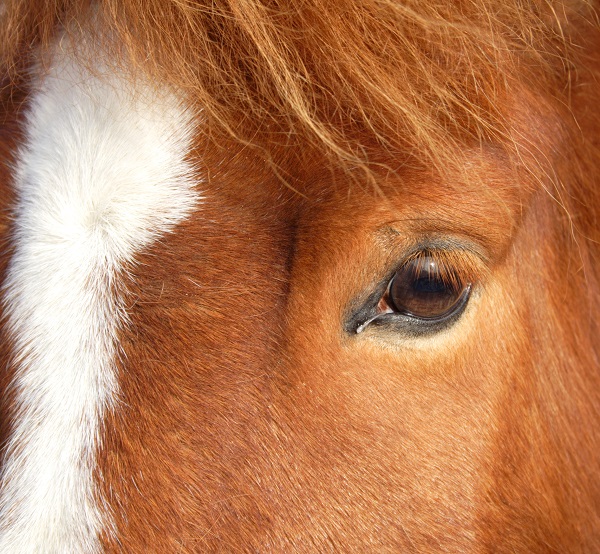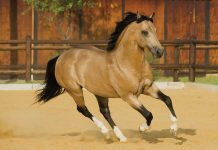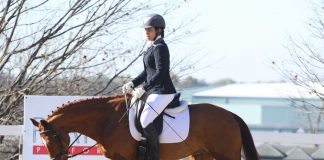Did you know that a horse’s eyes are a lot different than a human’s eyes? A human’s eyes are on the front of his head so he can see in front of him easily. A horse’s eyes are on the sides of his head so he can see all around him. But a horse has two blind spots—behind his rump and right in front of his nose.

This is why you must never approach a horse in his blind spot. If he can’t see you until the last second, he might get spooked and kick you or run away. This is why it’s best to approach a horse from the side and head towards his shoulder. Then he can see you and won’t be startled when you get close to him.
Signs of a healthy eye
- Shiny
- Bright
- Blinks when you wave your hand near it
Signs of an unhealthy eye
(call the vet!)
- Yellow discharge (pus) coming out of it
- Constant watering
- Swollen and red
- Squinting (keeping the eye closed)
Eye health
Equine eyes can be delicate so it’s important to look after them properly. Wipe off any gunk that appears around the eye with a clean, damp cloth or sponge. It’s a good idea to have a special sponge just for your horse’s eyes. Don’t use a sponge that you’ve used to wipe his dock area or nose because this can spread germs and might cause an eye infection.
If you notice that your horse has a red or swollen eye or if his eye is weeping non stop, it’s essential that you call the vet right away and describe the eye to her. The eye may have a foreign object in it, like a twig or piece of dirt that is causing discomfort.
You don’t want an eye to stay red and irritated for long because if it causes an infection, your horse could lose the eye!
Eye irritation can also be caused by something (a branch or dirt?) scratching the eye.
The vet will come out and “stain” your horse’s eye. This means she squirts a special liquid in the eye that helps her see foreign objects and scratches when she looks through an instrument called an opthalmoscope. By shining a beam of a light into the eye, the vet may be able to spot what’s causing the eye to be irritated.
If she spots a scratch or removes a foreign object, the vet will probably give you an antibiotic ointment or eye drops to put in the eye several times a day for three or four days. If the eye doesn’t improve, you may have to call a veterinarian who specializes in equine eyes.
How to apply eye medication
This can be tricky sometimes! Ask a pal to hold your horse’s lead rope to keep his head still. Then gently open his eye with your left hand and squirt the medication with your right hand into the front corner of his eye—the corner nearest his nose. When he blinks, the ointment should spread out over his eye. Only the medication should touch his eye—don’t poke him with the tube!
Here are some eye problems:
Conjunctivitis
Conjunctivitis is one of the most common eye ailments. It can be caused by infection or by a foreign object getting into the eye. The membranes around the eye become red and swollen. Conjunctivitis can be treated with antibiotic eye ointment and eye drops.
Watery eye
If an eye weeps constantly, it might mean that the horse has a blocked tear duct. If your vet suspects this, she’ll flush out the tear duct by running a small tube up his nose and squirting an antibiotic solution up into his tear ducts.
Lacerated eyelid
An eyelid can tear if it gets caught on something sharp like a nail or barbed wire. Most rips can be repaired if the vet treats the eyelid quickly. The vet will tranquilize your horse, wash the torn skin and then stitch the eyelid back together.
Cataracts
Cataracts are a degeneration of the lens of the eye. The first signs of cataracts are when a horse doesn’t see people or danger approaching from one side. The pupil loses its transparency and begins to look. Cataracts aren’t painful, but they can cause vision loss. Cataracts can be caused by infection or old age. There’s not much you can do about them when a horse is old, but sometimes they can be removed from young horses.
Third eyelid
If you notice a strange third eyelid stretching out over your horse’s eyeball, call the vet! Your horse may have a serious disease called tetanus. Tetanus is caused when bacteria enters a wound. It causes muscle spasms and can make a horse really sick. If a horse’s breathing is affected by these spasms, the horse could die. One of the signs of tetanus is a white eyelid that covers almost half of a horse’s eyeball. Prevent tetanus by vaccinating your horse against it every year.





